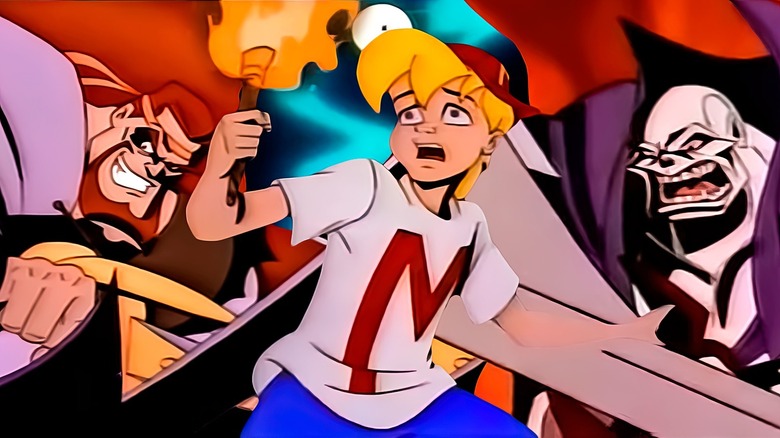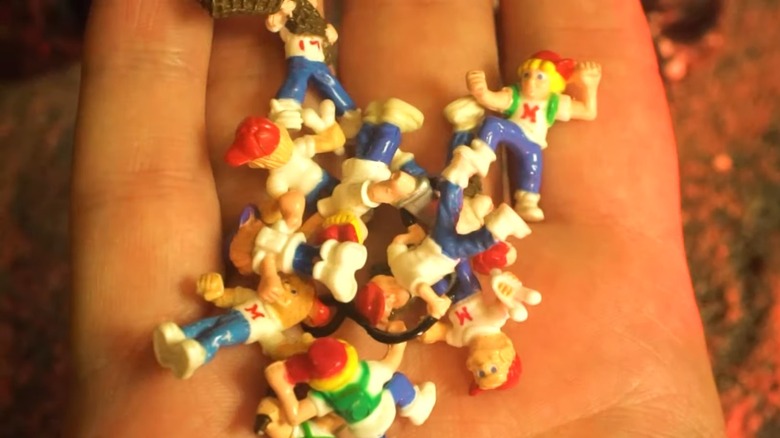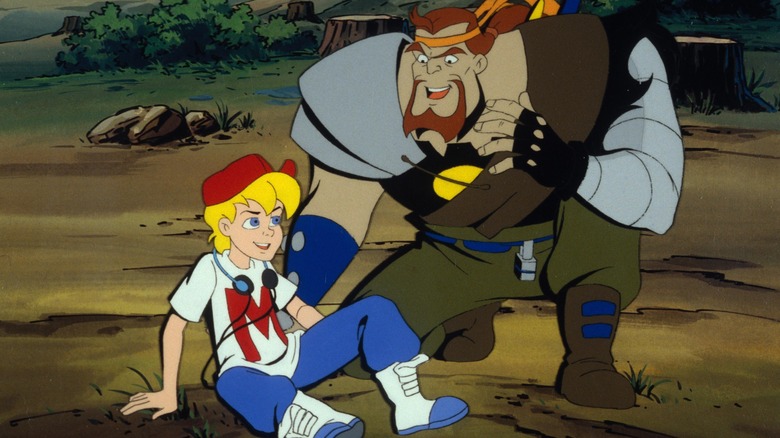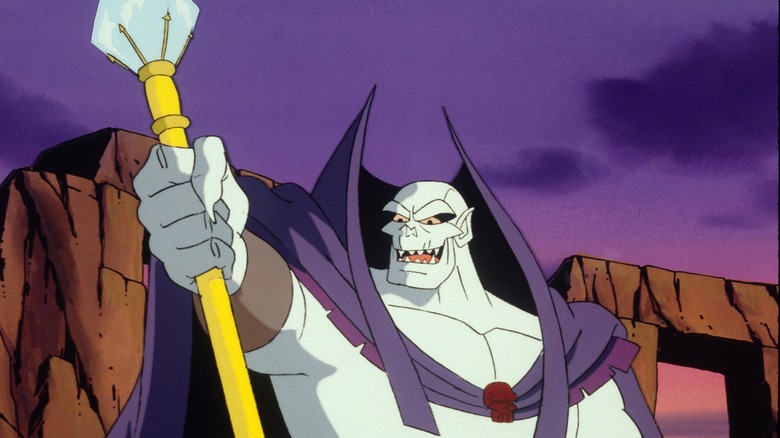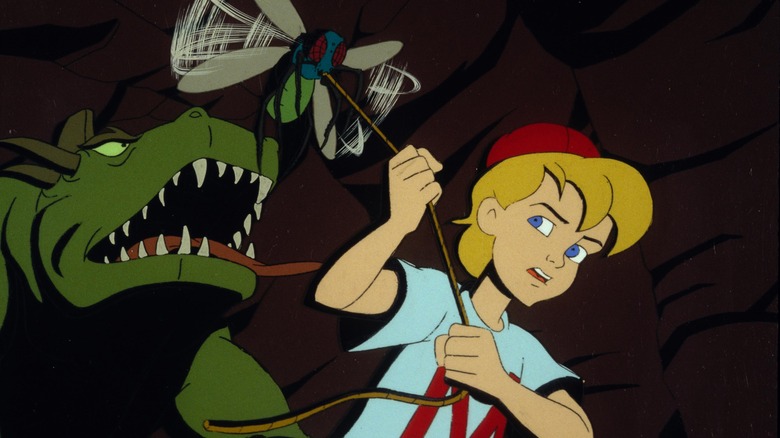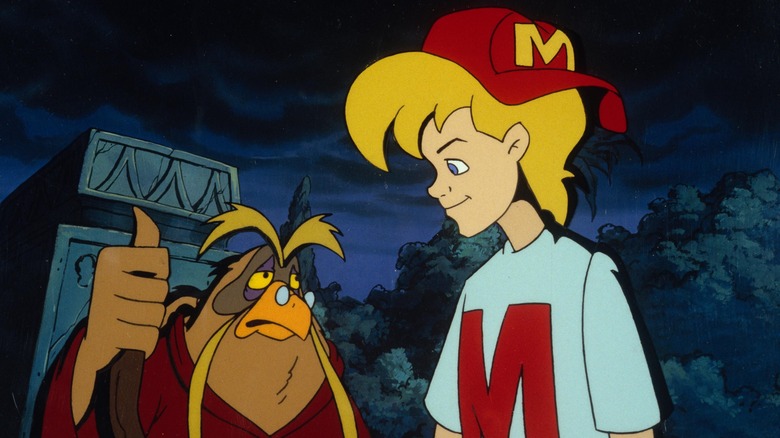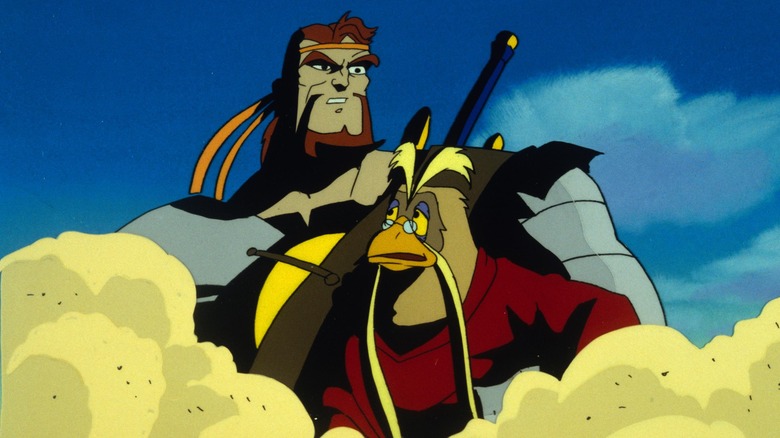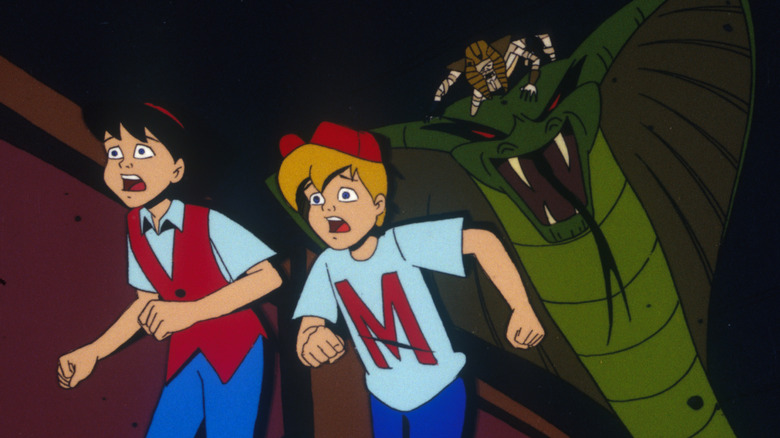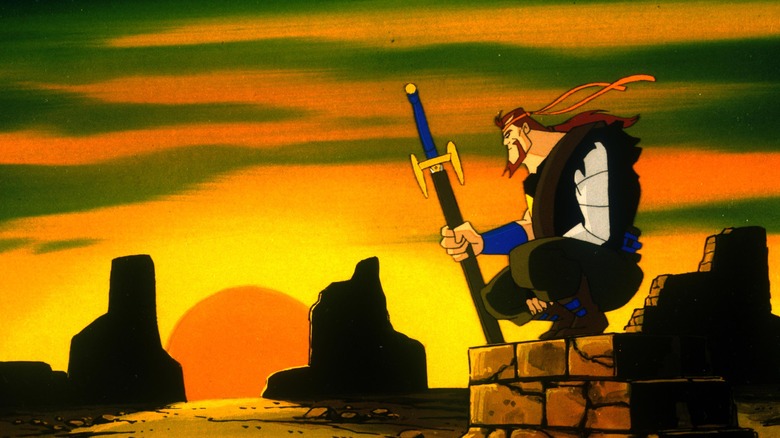Mighty Max Details That Even Skullmaster Can Appreciate
The world of cartoons was pretty strange in the 1990s, but there are a lot of hidden gems from the period that make it a fun era to revisit as an adult. Sure, some characters, episodes, and even entire series might leave us scratching our heads. Still, even when it gets rocky, it's a time of animation greatness, and it is usually worth the journey. Some shows, like "Batman: The Animated Series," remain hugely influential industry high points today, while others, like "Animaniacs" or "The Tick," have managed to stay hilarious while growing only more poignant with time. Then, there's "Mighty Max," a blink and you missed it series based on a popular toy line that has nearly vanished from pop culture conversation but makes for a surprisingly entertaining re-watch.
"Mighty Max" follows a teen boy named Max who receives a mysterious package one day. In the box is a statue of an owl and a message that says, "You have been chosen to be the Cap Bearer. Go to the Mini-Mart and wait for a sign, Mighty Max." Disclaimer: Following these instructions in real life would likely be a very bad idea, but follow them he does, right after breaking the statue and donning a baseball cap with teleportation abilities. After being promptly attacked by a monster sent by a mysterious entity called the Skullmaster, Max teams up with a helpful humanoid bird named Virgil and his bodyguard, a Viking named Norman.
With a built-in reference to Dante's "Inferno" in a children's cartoon, you may have guessed that this show is a wild ride, and, frankly, you'd be right. Here are some fascinating "Mighty Max" details that even the villainous Skullmaster can appreciate.
It's based on a toy line from the makers of Polly Pocket
Like so many cartoons of the 1980s and 1990s, "Mighty Max" is based on a toy line that's actually pretty awesome. Kicking off in the United Kingdom in 1992, the line came by way of Bluebird Toys, which was eventually sold to Mattel in the late 1990s. Founded in 1980 by literal knight and inventor of the Big Yellow Teapot House, Sir Torquil Norman, the company also developed the famous Polly Pocket line. In an era of very gendered toys, Polly Pocket was aimed at girls and featured makeup compact-shaped, brightly-colored cases and toys. Meanwhile, Mighty Max was intended for boys, and instead offered up a magical baseball cap and plenty of monsters for the young hero to face off against.
Much like the Polly Pocket line (which is still beloved to this day and even inspired a manicure trend in 2023), the Mighty Max toys featured some neat carrier cases. Referred to as Doom Zones and Horror Heads, the playsets doubled as easy transportation as well as a backdrop to create stories around. With names like Zomboid, Kronosaur, and Nuke Ranger, the villains are a lot of fun, and the cases offered prompts for play scenarios, such as "Mighty Max Defeats Vamp Biter" and "Mighty Max Outfreaks Freako." Some of these villains also turn up in the show, adding a sense of a shared universe between toy and TV.
The themes are surprisingly heavy
Nothing is meant to last forever, but "Mighty Max" lasted longer than you might think, airing from September 1993 until December 1994. In slightly over a year, the series produced two whole seasons, with forty episodes as the final tally. Although it could be dismissed as a cynical attempt to cash in on the toys, the cartoon is a bit too interesting for that, with a compelling supporting cast backing Max up and complex villains capable of changing their allegiances mid-fight. For instance, Norman taps into global mythologies while Virgil once mentored the Skullmaster, who ultimately repaid the favor by destroying his people. Pretty intense for a kids' cartoon.
Indeed, if you remember anything about this series beyond the magical baseball cap, chances are it's the surprisingly grim themes. The very trajectory of the series is a bit of a downward spiral, with a lack of moral conclusions that is uncommon for a children's cartoon even now. In fact, in the final episodes of the series, Max watches both Virgil and Norman perish in a battle against the Skullmaster. Rather than saving the day as one might expect, Max is deposited back at the beginning of the series and forced to begin his journey once more. While he's armed with new information that could change things, it's hard to get over the fact that he only "wins" on a technicality.
The cast was stacked
One of the wildest things about "Mighty Max" is that they went all out for voice talents, bringing in names that remain iconic in the world of animation today. The first name that springs to mind is Tim Curry, who turns what could be a one-note bad guy into a classic Curry villain with the Skullmaster. Then there's Max's portrayer, voice acting legend Rob Paulsen. He's known for his many roles in children's shows like "Teenage Mutant Ninja Turtles" and "Fraggle Rock," but also has some fascinating R-rated fare on his resume, such as the underrated folk horror film "Eyes of Fire" and cult classics like "Body Double" and "Warlock."
The list goes on with this series. Max's mom, an archeologist at the local museum, is played by the voice of Babs Bunny herself, Tress MacNeille, with fellow "Tiny Toons Adventures" actor Kath Soucie taking the role of Max's friend Bea. Frequent cartoon star Tony Jay plays Virgil, while "Night Court" alum Richard Moll portrays Norman. None other than the voice of Max Goof, Jason Marsden, plays Norman when he appears in child form via flashbacks in "Norman's Conquest," which also features Brad Garrett of "Everybody Loves Raymond" as his age-old nemesis, Spike. There's so much talent here that it's hard to believe "Mighty Max" became a footnote in cartoon history.
Those pun titles were incredible
While "Mighty Max" followed the TV rules of the time and stuck with a consistent formula to tell its stories, it's clear that the people behind the show were having a lot of laughs along the way. Most of the episodes feature clever puns for titles, such as "The Maxnificant Seven," "Beetlemania," and "Armageddon: Outta Here." Beyond those stellar names, the episode subjects never cease to surprise, with Max's teleportation powers opening up the universe to his travels. With the primary goal of defeating the Skullmaster on lock for Max and his friends, most of the show is spent battling Skullmaster's subordinates and hopping around ancient history.
Yes, "Mighty Max" uses a lot of genre tropes in its making, but it has a blast doing it so it never feels particularly stale or hackneyed. Besides that, the villains can be genuinely scary, with the bad guy of "Scorpio Rising" hoping to destroy Earth with nuclear power and a fly-vampire hybrid terrorizing the streets of London in "Fly By Night." While it seldom deals in moral absolutes, it taps into world mythology and historical fact for its plots. In the end, this is a series that defies expectations more often than not, making the occasionally off-kilter pacing and slightly annoying one-liners from Max feel worth it. It certainly wasn't afraid to test the boundaries, and you'll likely be shocked at some of the stuff they got away with when re-watching the show today.
Breaking the fourth wall
Animated kids' shows of the '90s often featured a little victory lap at the end of the episode to wrap up the plot threads for young viewers and tease the next episode. Similarly, "Mighty Max" episodes generally feature short epilogues in which Max speaks directly to the audience, effectively breaking the fourth wall for long enough to drop a few pearls of wisdom for viewers. While Virgil would drop knowledge on Max and thereby the audience at large, these epilogues helped wrap things up in an informative way. It would be a pretty big stretch to refer to any part of the series as "fact-based," but the writers used this space to loop the plot back to the IRL places and events that inspired it.
These facts are far from being absolutely vital to the series, but they helped set the tone, and for a show aimed at kids, they're impressively educational. These segments generally take place in Max's bedroom where he can engage comfortably in a way that feels one-on-one, but, like the show itself, he sometimes travels to new locations to help make his points. These tidbits sometimes even explain major character beats, with one of them revealing that the legends of many great mythological heroes were actually inspired by Norman. Without watching to the end, viewers could miss out on some pretty big details, as well as a number of fun facts.
The video games and comic books are hard to get hold of
Most fans would admit that the toys overshadow the animated series in the pop culture lexicon by a pretty wide margin. However, that doesn't mean this wasn't a franchise that did what it could to expand. On top of its many toy offerings, 1995 saw the release of a Sega Genesis game based on the series titled "The Adventures of Mighty Max." The unenthusiastic reviews from gamers at the time (it was described as "an incredibly slow and plodding game" by Electronic Gaming Monthly) and the lack of a follow-up indicate that it wasn't exactly a revelation for most. Tiger Electronics also released a handheld game based on the series, but if you've played one Tiger Electronics handheld game from the '90s, you've played them all.
Another now-mythical "Mighty Max" merchandising attempt is the comic book series. Released only in the United Kingdom by Marvel UK, it's pretty difficult to find a copy of any issue of this series today. It had at least one big name working behind the scenes, with comics legend Dan Abnett (who has had runs on "Guardians of the Galaxy," "The Punisher," and a number of "X-Men" titles) penning several issues. The series ran for ten issues with a #0 special edition available only with the purchase of the Sega game. Copies can be tracked down via independent dealers on platforms like eBay, but they're pretty rare these days.
A lot of toys never saw the light of day
With so many toys, playsets, and even digital watches under its belt, it might come as a surprise that the final leg of "Mighty Max" toys simply never came to be. After two seasons of the show and four years of the action figure line, the whole franchise more or less vanished from the shelves, apparently without much ado. With little information to go off, we're left to guess that there was simply a downturn in sales, and, after a series of attempted takeovers before selling to Mattel, Bluebird went the way of so many toy manufacturers of the age. While Polly Pocket has long since returned to the market, Mighty Max has yet to see that kind of push for a modernized take.
Perhaps most perplexingly for fans, it seems that the plan for more Mighty Max toys was pretty much in the bag. With the 1996 SKU list showing a lot of new offerings, and plenty of prototypes known to have been created, it feels like a missed opportunity. Still, the sheer number of sets and figures released over the near-half decade the toy line was in production is pretty incredible. Today the toys exist mostly in the realm of collectors and aficionados, but you never know with this franchise what surprises might be on the way.
Good luck finding it
Despite everything that "Mighty Max" had going for it, the TV series and the toy line alike are today somewhat obscure, making the franchise something of a curiosity. While some episodes were released via VHS, it's never been made available through streaming or DVD. Even the cancelation of the series remains somewhat difficult to explain, with little in the way of solid facts available. Even with a Sega game, a McDonald's Happy Meal tie-in, and a massively successful toy line in its corner, there's apparently little in the way of interest in making the series more widely available.
Yet, as recently as November 2022, Geek Outpost covered the work of The Mighty Max Restoration Project, a YouTube channel working to remaster the cartoon so that it can be enjoyed by a new generation. This might not lead to a full-on rejuvenation of the concept, but it's still a pretty cool project. If you're looking for a re-watch of this cult cartoon, or if you're just in the mood for a first-time jaunt through '90s fashion and one-liners, you could do a lot worse than checking "Mighty Max" out on YouTube.
